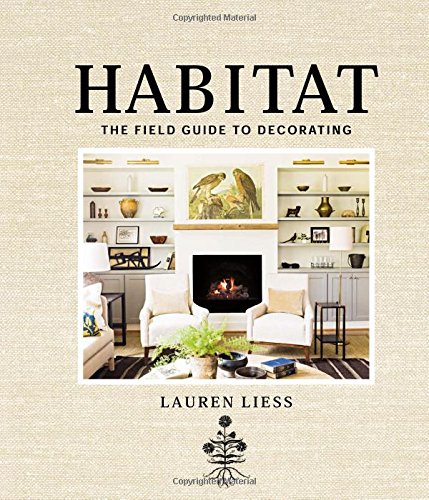- You are here:
- Home »
- Interior Decorating »
- Habitat: The Field Guide to Decorating
Habitat: The Field Guide to Decorating


Lauren Liess, an interior designer and founder of the popular blog Pure Style Home, fuses her love of design and the great outdoors into all her work. In Habitat: The Field Guide to Decorating, her first book, Lauren invites readers to bring nature inside by mixing the textures of natural elements such as wood and stone with eclectic groupings of modern and quirky vintage pieces. Readers will be inspired by the unique style of these rooms, which include lovely framed botanical prints and Liess’s own textile patterns inspired by wildflowers and weeds. The book is divided into three sections: Part I focuses on the fundamental elements of design, with each chapter devoted to a particular element, such as color, lighting, and furniture; Part II addresses the intangibles of designing a space, such as aesthetics and creating a mood; and Part III tackles unique room-specific challenges in every part of the house.
Product Features
- Abrams
"Click Here!!! to get the best picture, get the best deal, lowest price and more detailed differences and similarities of the product as well as some more important information affecting your purchasing decision."Click Here
Session expired
Please log in again. The login page will open in a new tab. After logging in you can close it and return to this page.

Bland This book is divided into three main sections:Fundamentals of design: Includes the basic elements. Examples include architecture (which many people aren’t at liberty to change), finishes and hardware, floor plan, rugs, furniture, color, etc. This section provides some basic information in each area. It was a good read, but I don’t see me referring back to it at any time.Intangibles of design: Aesthetic, style, mood, authenticity, juxtaposition, etc. While I think it is important to get a good understanding of your own personal preferences, I didn’t find the chapters on aesthetic, style or mood very helpful. She includes worksheets that I would not find helpful either.Regarding authenticity, my home was built about 18 years ago – I don’t think wandering around the neighborhood is going to help me much, and I think that there are ways to introduce styles into a home that isn’t particular to the era it was built. I also interpreted that the designer wants the…
Good, But Mostly For The Rich Generally speaking this is a good book, and the five-star reviews are fair. But is just not for me, and I suspect not for the vast majority of individuals. It seems great for interior designers or those who have lots of money and space to create their dream house. But, like, I’m a renter. What am I doing with a book that says the first step decorating your home might be knocking out a wall? I have tons of student loans. What am I doing with a book that suggests buying a rug that can become an heirloom? Some of the more general advice about topics such as juxtaposition, mood, and luxury (which isn’t necessarily expensive, just something special, even if it’s just some pretty greenery from outside) were good, but I didn’t see much about translating them to a smaller, restricted space on a budget. The whole thing, from the language to the pictures, just feels unattainable to me, so much that I feel silly for owning the book.I have been following the author’s blog for years,…
A useful field guide for decorating! Wonderfully written and beautiful to hold. Reading it was like finding a treasure trove of design secrets and tips. Lauren’s down to earth and personal reflections were inspiring as well as practical and helpful. My favorite quote from the book is, “Most people in the world do not have this luxury; many have no homes at all. So enjoy the process, and try not to wish or worry it away.”